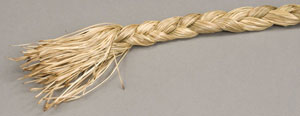




Advanced Search
Dress Up | 1st Person | African American Map | Now Read This | Magic Lens | In the Round | Tool Videos | Architecture | e-Postcards | Chronologies Turns Activities
Wôbanaki Girl's Clothing from 1700As a very young girl or boy, a Wôbanaki child might wear only a breechclout or nothing at all in the warm weather. Otherwise, they would dress the same as their parents. Wôbanaki people slept in whatever was most suited for the season. In the winter this would mean wearing several layers to bed, and in the hot weather a child might sleep without clothing. Among the numerous items available through trade in the 1700s were wool and linen cloth, ready-made shirts, knitted wool hats and mittens, glass beads, brass kettles, and metal axe heads and knife blades. Native American people in New England would trade with the French in New France or the English in the American colonies. Items they received might come from England, France, Holland, or as far away as India. Go to interactive Flash version
ShiftThis girl wears a linen shift. It is a trade item and is the same style worn by French and English girls. European girls wore shifts under their petticoats (skirts) and covered them up with other layers of clothing. Wôbanaki girls and women typically wore shifts and shirts outside of their skirts or petticoats.
Comb & MirrorThe comb and mirror are trade items. The Abenaki call a mirror a “pipinawiakwigan”.. The comb this girl is using to comb tangle from her hair is called a “naskuahon. ” It is made from cow horn.
Wrap-around SkirtThis skirt is made of wool cloth and decorated with ribbons. The skirt wraps around the waist and a sash is tied on to keep the skirt in place. Wrap skirts and petticoats are called “labizowan”.
LeggingsThese are wool leggings, called “medasal”. They are tied to a belt at the waist to keep them up. Leggings were worn for warmth and to protect one's legs when walking through scratchy undergrowth. MoccasinsThese are summer-weight moccasins with a center seam. They are made from the hide of a white-tailed deer. The Abenaki call all kinds of shoes "mkezenal". The English adapted this word into “moccasin”.
Sash & GartersThis girl wears a sash around her waist and garters, called “kiganibial.” They are tied on just under her knees. The sash and garters are made from wool yarn, using a technique called "fingerweaving". As the name suggests, fingerweaving is a way to weave by using just the fingers, instead of weaving on a loom. The garters help to keep the girl's leggings in place.
NecklaceThis girl wears several necklaces, made of glass beads and one made from brass rings. A necklace is called a “nôpkoan”, a thing that circles. These rings were called "bagues a cachet" (plaque rings) by the French, and were given to Native people by traders, soldiers, politicians, and Catholic priests.
|
| |
Home | Online Collection | Things
To Do | Turns
Exhibit | Classroom | Chronologies My
Collection
About This Site | Site Index | Site Search | Feedback
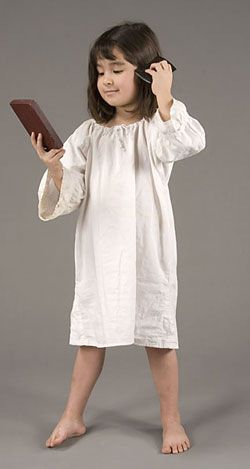
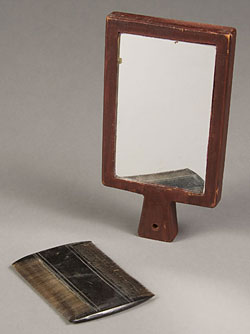

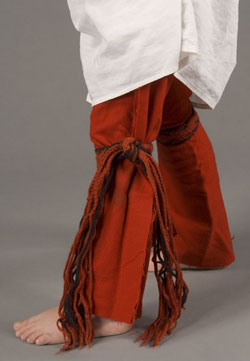
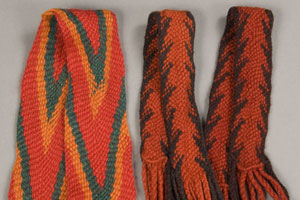
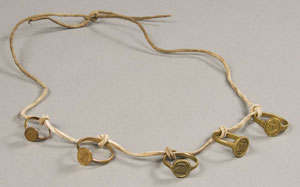
 Capot
Capot
